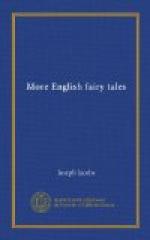Source.—Halliwell, Nursery Rhymes.
Parallels.—It is possible that this is an Eastern “sell”: it occurs at any rate as the first episode in Fitzgerald’s translation of Jami’s Salaman and Absal. Jami, ob. 1492, introduces the story to illustrate the perplexities of the problem of individuality in a pantheistic system.
Lest, like the simple
Arab in the tale,
I grow perplext, O God!
’twixt ME and THEE,
If I—this
Spirit that inspires me whence?
If THOU—then
what this sensual impotence?
In other words, M. Bourget’s Cruelle Enigme. The Arab yokel coming to Bagdad is fearful of losing his identity, and ties a pumpkin to his leg before going to sleep. His companion transfers it to his own leg. The yokel awaking is perplexed like the pantheist.
If I—the
pumpkin why on YOU?
If YOU—then
where am I, and WHO?
LVI. TATTERCOATS
Source.—Told to Mrs. Balfour by a little girl named Sally Brown, when she lived in the Cars in Lincolnshire. Sally had got it from her mother, who worked for Mrs. Balfour. It was originally told in dialect, which Mrs. Balfour has omitted.
Parallels.—Miss Cox has included “Tattercoats” in her exhaustive collection of parallels of Cinderella (Folk-Lore Society Publications, 1892), No. 274 from the MS. which I had lent her. Miss Cox rightly classes it as “Indeterminate,” and it has only the Menial Heroine and Happy Marriage episodes in common with stories of the Cinderella type.
Remarks.—Tattercoats is of interest chiefly as being without any “fairy” or supernatural elements, unless the magic pipe can be so considered; it certainly gives the tale a fairy-like element. It is practically a prose variant of King Cophetua and the Beggar Maid, and is thus an instance of the folk-novel pure and simple, without any admixture of those unnatural incidents which transform the folk-novel into the serious folk-tale as we are accustomed to have it. Which is the prior, folk-novel or tale, it would be hard to say.
LVII. THE WEE BANNOCK
Source.—Chambers’s Popular Rhymes of Scotland. I have attempted an impossibility, I fear, in trying to anglicise, but the fun of the original tempted me. There still remain several technical trade terms requiring elucidation. I owe the following to the kindness of the Rev. Mr. Todd Martin, of Belfast. Lawtrod = lap board on which the tailor irons; tow cards, the comb with which tow is carded; the clove, a heavy wooden knife for breaking up the flax. Heckling is combing it with a heckle or wooden comb; binnings are halters for cattle made of sprit or rushes. Spurtle = spoon; whins = gorse.




